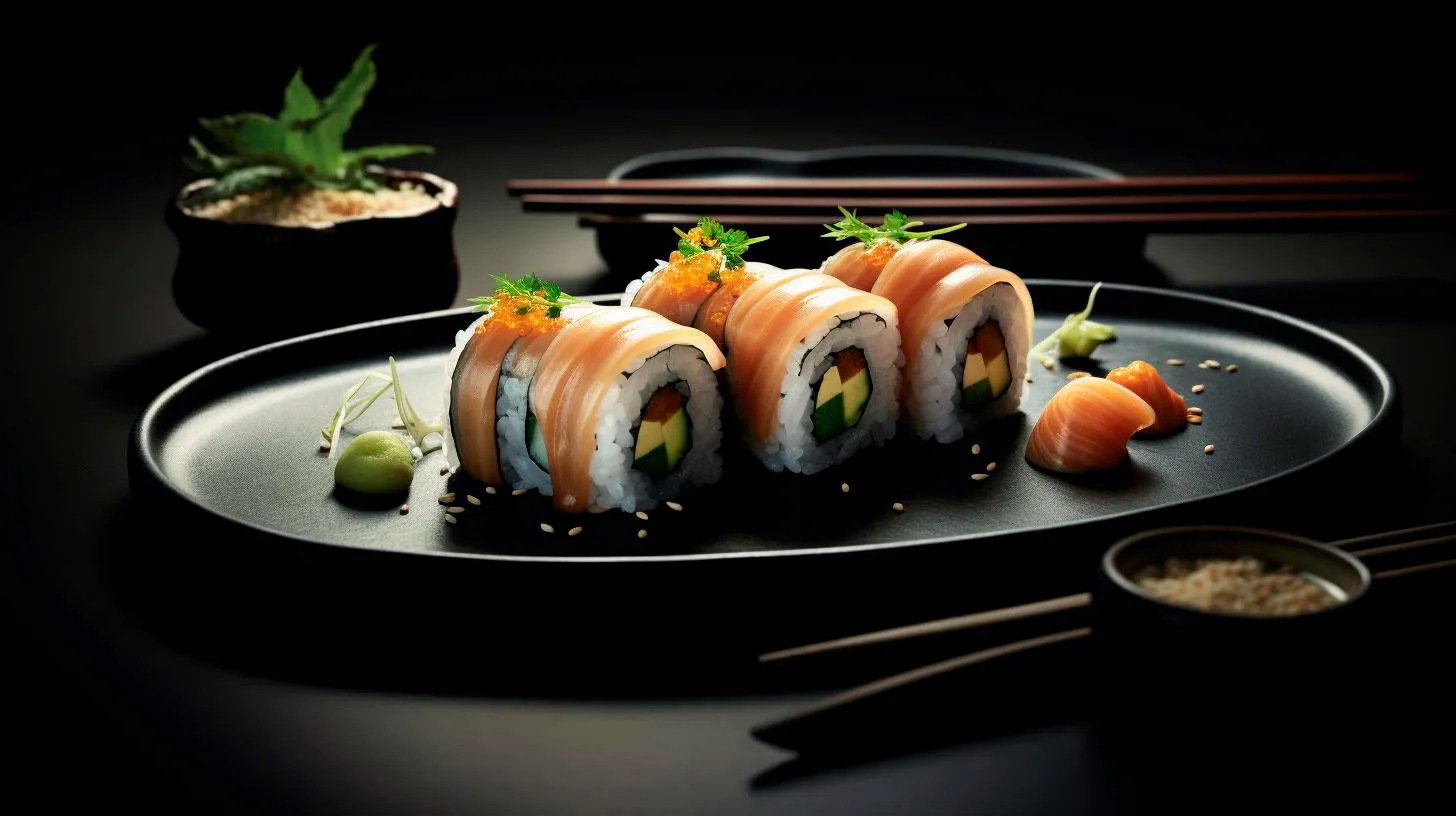Unlocking the Secrets of Perfect Sushi Knife Handling
In this article, we will uncover the secrets to perfect sushi knife handling and provide you with some valuable tips to elevate your sushi-making game.
Before we get into the specifics of sushi knife handling, let’s understand why it is crucial to use the right knife for the job. The traditional Japanese sushi knife, known as a Yanagiba, is designed specifically for slicing through delicate fish and creating precise cuts. Its single-edged blade and ultra-sharp edge allow you to make clean cuts without damaging the delicate texture of the fish.
Key Takeaways:
- Using the right knife is crucial for perfect sushi knife handling.
- The Yanagiba knife is the traditional Japanese sushi knife.
- A single-edged blade and sharp edge are essential for clean cuts.
Proper Grip and Technique
Now, let’s move on to the proper grip and technique of handling a sushi knife. A good grip ensures control and precision while cutting through the fish and other ingredients. Here’s how to master the perfect grip:
- Hold the handle of the knife firmly but not too tightly. This will give you better control and reduce the risk of slippage.
- Place your index and middle fingers on one side of the blade, while placing your thumb on the other side. This grip technique provides stability and control.
- Your other hand should be used to hold the food item you are slicing. By using your non-dominant hand to hold the ingredient, you can ensure steady and accurate cuts.
In terms of technique, it is important to maintain a consistent motion when slicing through the fish. A gentle and fluid motion will result in clean cuts and maintain the integrity of the ingredients. It is advisable to slice through the fish in a single, continuous motion, avoiding any back and forth movement that can damage the texture.
Key Takeaways:
- Hold the handle of the sushi knife firmly but not too tightly.
- Use a grip technique that provides stability and control.
- Maintain a consistent and fluid motion when slicing through the fish.
Knife Care and Maintenance
Proper care and maintenance of your sushi knife are essential to ensure its longevity and performance. Here are some key tips for keeping your knife in top shape:
- After each use, wash the knife with warm water and mild detergent. Avoid using abrasive sponges or cleaners that can damage the blade’s edge.
- Dry the knife thoroughly with a soft cloth to prevent any moisture buildup that can lead to rust.
- Store the knife in a knife sheath or a wooden saya to protect the blade and prevent any accidental injuries.
- Regularly sharpen your knife using a sharpening stone or a honing rod to maintain its sharpness and cutting precision.
By following these care and maintenance tips, you can ensure that your sushi knife remains in excellent condition, allowing you to create perfect slices every time you prepare sushi.
Key Takeaways:
- Wash the knife after each use with warm water and mild detergent.
- Dry the knife thoroughly to prevent rust.
- Store the knife in a protective sheath or saya.
- Regularly sharpen your sushi knife to maintain its sharpness.
Advantages of Perfect Sushi Knife Handling
Mastering the art of sushi knife handling can do wonders for your sushi-making skills. Here are some advantages that come with perfect sushi knife handling:
- Precision: When you can slice through delicate fish with precision, it enhances the overall presentation of your sushi dishes.
- Texture: Perfectly sliced fish retains its texture, allowing you to fully appreciate the flavors of the sushi.
- Efficiency: With proper knife handling techniques, you can work faster and more efficiently, saving time in your sushi preparation process.
- Safety: By using the correct grip and technique, you minimize the risk of accidents and ensure a safe cooking environment.
These advantages make investing time and effort in mastering sushi knife handling well worth it, as it will greatly enhance your culinary experience when preparing and consuming sushi.
In Conclusion
Unlocking the secrets of perfect sushi knife handling is a journey that requires practice, patience, and precision. By using the right knife, mastering the proper grip and technique, and caring for your knife diligently, you can elevate your sushi-making skills to a whole new level. Enjoy the process, savor the flavors, and continue to hone your skills in the art of sushi knife handling.
Level Up Your Sushi Game: Essential Knife Skills for Success
In this article, we will explore the essential knife skills you need to level up your sushi game and impress your guests.
The Right Knife for the Job
Before diving into the techniques, let’s discuss the importance of using the right knife for sushi preparation. The most commonly used knife in sushi-making is the Yanagiba, also known as the Sashimi knife. This long, slender knife has a single-edged blade, which allows for precise cuts and slices through various types of fish with ease. The Yanagiba knife ensures clean and smooth cuts, preserving the integrity of the ingredients.
Key takeaways:
- Invest in a Yanagiba knife for precise sushi cuts.
- Single-edged blades provide clean and smooth slices.
- Proper cutting techniques preserve the integrity of the ingredients.
Mastering Knife Techniques
Now that you have the right knife, it’s time to master the essential knife techniques for sushi preparation.
1. Slicing (Yanebiki)
Slicing is the most basic and essential technique used in sushi-making. To slice fish or seafood, hold the knife at a 30-degree angle and gently glide it through the fish in one swift motion. Practice is key to achieving uniform slices of a consistent thickness.
2. Filleting (Nigiri)
Filleting is essential when preparing fish for Nigiri, a popular type of sushi. Start by removing the skin and bones, if any, from the fish. Then, slice the fish perpendicular to the muscle fibers, ensuring each slice is consistent in size and thickness. This technique requires precision and practice to achieve beautifully shaped Nigiri.
3. Chopping (Katsuramuki)
Chopping is commonly used for vegetables such as cucumbers or carrots in sushi rolls. Start by removing the ends and peeling the skin off the vegetables. Then, hold the knife at a slight angle and make thin, even slices along the length of the vegetable. Roll up the slices tightly to create beautiful, textured fillings for your sushi rolls.
Key takeaways:
- Practice slicing, filleting, and chopping techniques for precise cuts.
- Consistency in size and thickness is crucial for visually appealing sushi.
- Master the art of Nigiri preparation with precise filleting techniques.
The Advantages of Knife Skills
Having proficient knife skills in sushi-making offers several advantages:
1. Enhanced Presentation
Mastering knife skills allows you to create visually stunning sushi dishes. Neatly sliced fish and precisely chopped vegetables contribute to the overall presentation of your sushi creations, impressing both the eyes and taste buds of your guests.
2. Improved Taste and Texture
Precise knife techniques ensure that the ingredients are cut properly, enhancing the taste and texture of the sushi. Clean cuts and consistent thickness result in a harmonious dining experience as each bite delivers balanced flavors and textures.
3. Time Efficiency
Efficient knife skills save time in the sushi-making process. With practiced techniques, you can quickly and accurately prepare the ingredients, allowing for faster assembly of sushi rolls or Nigiri.
Key takeaways:
- Proficient knife skills enhance the presentation of your sushi.
- Proper cutting techniques improve taste and texture.
- Efficiency in knife skills saves time during sushi preparation.
Now that you’ve acquainted yourself with the essential knife skills for sushi-making, it’s time to hit the cutting board and practice. Remember, practice makes perfect, and with time, you’ll master the art of beautifully crafted sushi. Elevate your sushi game with these knife skills, and delight your guests with the visual and culinary experience of authentic sushi.
Mastering the Art of Sushi Knife Skills
Behind the scenes, however, lies the mastery of sushi knife skills that separates an amateur from a true sushi chef. In this article, we will dive into the world of sushi knife skills and explore the techniques, advantages, and key takeaways that every aspiring sushi chef should know.
The Importance of High-Quality Sushi Knives
Before we delve into the techniques, it’s crucial to understand the significance of using high-quality sushi knives. A sharp and well-crafted sushi knife not only enhances your slicing precision but also ensures your safety in the kitchen. Here are some key benefits of investing in good sushi knives:
- Precision: A high-quality sushi knife allows for incredibly precise cuts, resulting in beautifully crafted sushi rolls and sashimi.
- Safety: Dull or low-quality knives can be dangerous as they may slip or require excessive force to make cuts. Good sushi knives ensure safer handling and reduce the risk of accidents.
- Durability: Quality sushi knives, made from high-grade steel, are built to last. They retain their sharpness for longer periods, eliminating the need for frequent replacements.
Mastering the Techniques
Now that we understand why investing in high-quality sushi knives is essential, let’s explore some fundamental techniques that will help you master the art of sushi knife skills:
1. Proper Grip
The way you hold your sushi knife greatly influences your control and precision. Hold the handle firmly with your dominant hand, maintaining a relaxed grip. Place your index finger on the back of the blade for added stability. Practice different grips to find the one that suits you best.
2. The Tip Control
The tip of the sushi knife is responsible for delicate and precise cuts. Mastering the control of the tip enhances your ability to create intricate decorative cuts, essential for visually stunning sushi presentations.
3. The Power of Weight
As with any knife, the weight of the sushi knife plays a vital role in the cutting process. Utilize the knife’s weight to apply consistent pressure while slicing through various ingredients. This technique helps achieve uniform cuts and prevents crushing delicate textures.
4. The Swift Slice
Sushi knife skills require swift and fluid movements. Apply controlled pressure and let the knife do the work instead of forcing it. Always maintain a gentle forward-and-back motion to create clean cuts and maintain the integrity of the ingredients.
Key Takeaways
Mastering sushi knife skills is an art in itself, requiring patience, practice, and a deep understanding of the techniques involved. Here are the key takeaways to remember:
- Invest in high-quality sushi knives to elevate your sushi-making experience.
- Proper grip and tip control are crucial for precision and decorative cuts.
- Utilize the weight of the knife for consistent and uniform cuts.
- Practice fluid movements and a gentle forward-and-back motion for clean cuts.
Becoming a skilled sushi chef takes time, but the journey is truly rewarding. By honing your sushi knife skills, you can create stunning culinary creations and captivate your guests with authentic Japanese flavors. Remember, practice makes perfect, so grab your sushi knife and start mastering the art today!
Enhance Your Culinary Expertise with Sushi Knife Techniques
While many people associate the key to great sushi with fresh ingredients and proper seasoning, the significance of using the right knife and technique cannot be underestimated. A sushi knife, also known as a Yanagiba or Sashimi knife, is an essential tool for any sushi chef or enthusiast. Its long, narrow blade design, sharp edge, and thinly ground cutting edge allow for precise and clean cuts, ensuring each slice of fish or vegetable maintains its flavor and texture.
Benefits of Using a Sushi Knife:
- Precision: The sharpness and design of a sushi knife allow for accurate and precise cuts, resulting in visually appealing and mouthwatering sushi rolls.
- Efficiency: With its long and narrow blade, a sushi knife allows you to slice through large pieces of fish or vegetables effortlessly, saving you valuable time and effort.
- Control: The ergonomic handle and balanced weight of a sushi knife provide you with better control over your cuts, reducing the risk of accidents and ensuring consistent results.
- Longevity: A sushi knife, when properly cared for, can last for years, making it a worthwhile investment for any sushi lover or professional chef.
Key Sushi Knife Techniques:
1. Slicing
Mastering the slicing technique is crucial for creating perfect sushi rolls. Hold the sushi knife at a slight angle and make long, smooth strokes from the heel to the tip of the blade. Maintain a steady pressure and let the knife do the work for you, ensuring each slice is even in thickness.
2. Filleting
When filleting fish for sushi, precision is key. Start by placing one hand firmly on the fish, using your fingers to hold it in place. With the sushi knife, make a gentle incision along the backbone, using the entire length of the blade. Gradually separate the flesh from the bones, maintaining a steady and controlled motion until you have a beautifully filleted piece of fish ready for sushi.
3. Cutting Vegetables
Whether it’s cucumber, avocado, or other vegetables, using the proper technique can make a significant difference in the outcome of your sushi rolls. For cucumbers, cut them into thin, uniform slices by holding the knife at an angle and using a rocking motion. When dealing with avocado, use a sushi knife to slice through the flesh smoothly, ensuring clean and consistent cuts.
Takeaways:
- Investing in a high-quality sushi knife is essential for anyone serious about sushi making.
- Proper sushi knife techniques, such as slicing, filleting, and cutting vegetables, can enhance the visual appeal and taste of your sushi rolls.
- Using a sushi knife allows for precise cuts, increased efficiency, better control, and long-lasting durability.
Mastering the art of sushi knife techniques takes practice, patience, and a genuine passion for creating exquisite sushi. With the right tools and a commitment to improving your skills, you can elevate your culinary expertise and impress friends and family with your sushi-making abilities. So, grab your sushi knife, explore different cutting techniques, and embark on a journey to become a sushi master in your own kitchen!



